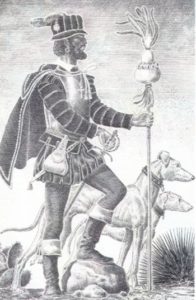
Estevanico
*The birth of Estevanico is celebrated on this date in c 1503. Estevanico was a Black North African interpreter with Spain’s exploration of the Americas.
He was a native of Azamor on the Atlantic coast of Morocco. In Spain before 1527, he was baptized as a Catholic and became the slave of Andrés Dorantes de Carranza. He accompanied his master as a Pánfilo de Narváez expedition member, approximately 300 men who landed in mid-April 1528 near present-day Tampa Bay, Florida. Permanently separated from his support vessels, Narváez and his command marched up the inner Florida coast and, by late summer, arrived near the mouth of the Wakulla River in the Florida panhandle.
At that time, the surviving Spaniards and at least one African numbered less than 250 men, the others having died of accidents or been killed by Indigenous natives. Narváez chose to slaughter his horses, build five makeshift barges, and attempt to sail along the Gulf Coast toward Mexico. The five rafts left Florida in September, and the craft containing Estevanico was placed under the joint command of Dorantes and Alonso Castillo Maldonado. After a month at sea, that raft landed on Galveston Island, or perhaps more likely to the west of it. By spring 1529, those three men, the only survivors from their craft, had traveled on foot down the (now) Texas coast to the environs of Matagorda Bay.
They were later captured and enslaved by Coahuiltecan Indians who lived southwest of the Guadalupe River. In the fall of 1532, the three men were joined in slavery by Álvarez Núñez Cabeza de Vaca, the sole survivor from a second raft. By early 1535, these four survivors had escaped their captors by fleeing south along the inner coast and entering Mexico near the Falcón Lake Reservoir. Estevanico was the first African to traverse Texas and reentered Texas in the company of three Spaniards from Mexico at La Junta de Los Ríos. They traveled across northwest Mexico to the Pacific Coast from La Junta. Throughout their travels in Texas and Mexico, the Spaniards and Estevanico gained a reputation and sustenance as faith healers. After walking south along the Pacific Coast, the four men encountered Spaniards north of San Miguel de Culiacán and then traveled to Mexico City, arriving there in late July 1536.
By 1539, Dorantes had sold Estevanico to Viceroy Antonio de Mendoza, who assigned the African to the company of Fray Marcos de Niza and was charged with leading a follow-up expedition toward lands visited by the survivors. On March 21, 1539, the Niza expedition arrived at the Río Mayo in present-day Sonora. There, Estevanico, apparently restless over the slow progress of the friar and his large party, was sent ahead as an advance scout. Separated by several days’ travel from the friar and his entourage, Estevanico approached the Zuni pueblo of Hawikuh in western New Mexico, where he was killed. Francisco Vázquez de Coronado, upon reaching Hawikuh one year later in 1540, reported to the viceroy that “Estevanico’s death was because of his cruelties and assaults on American Indian women.”